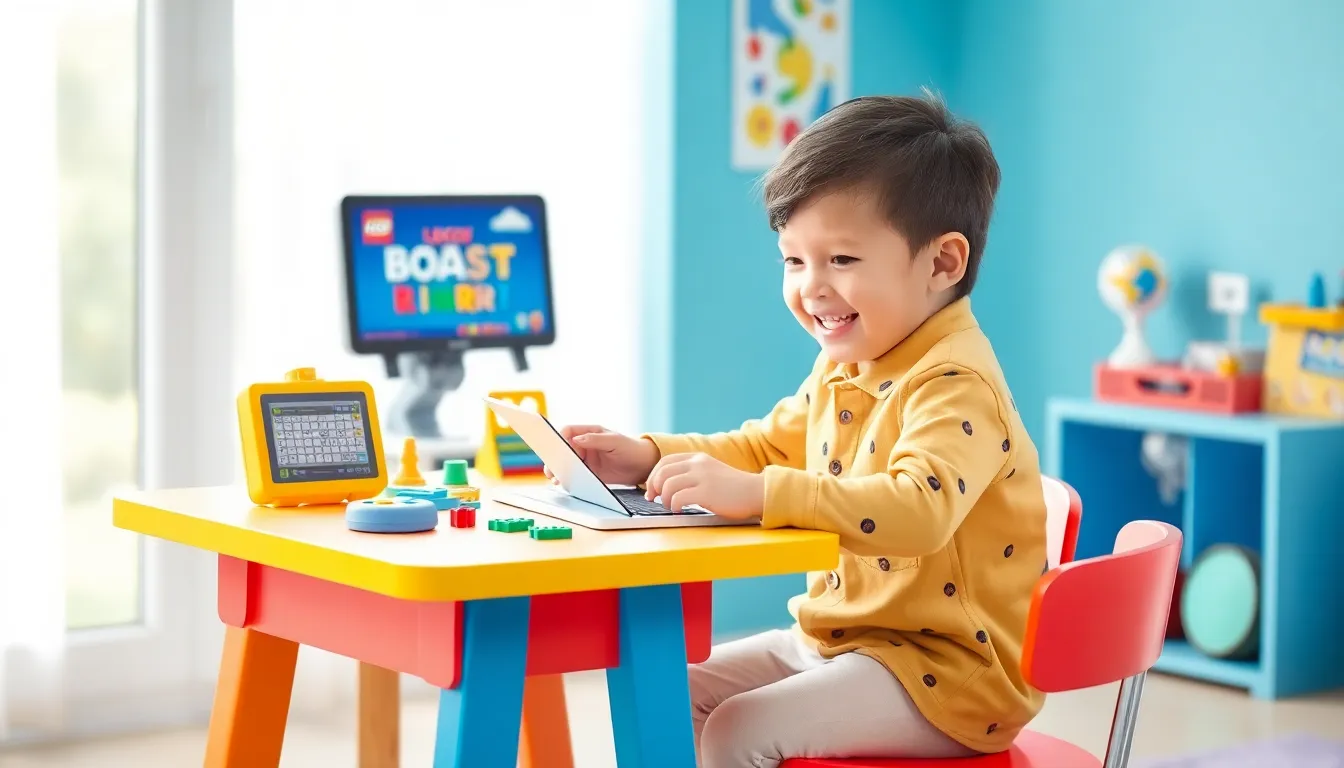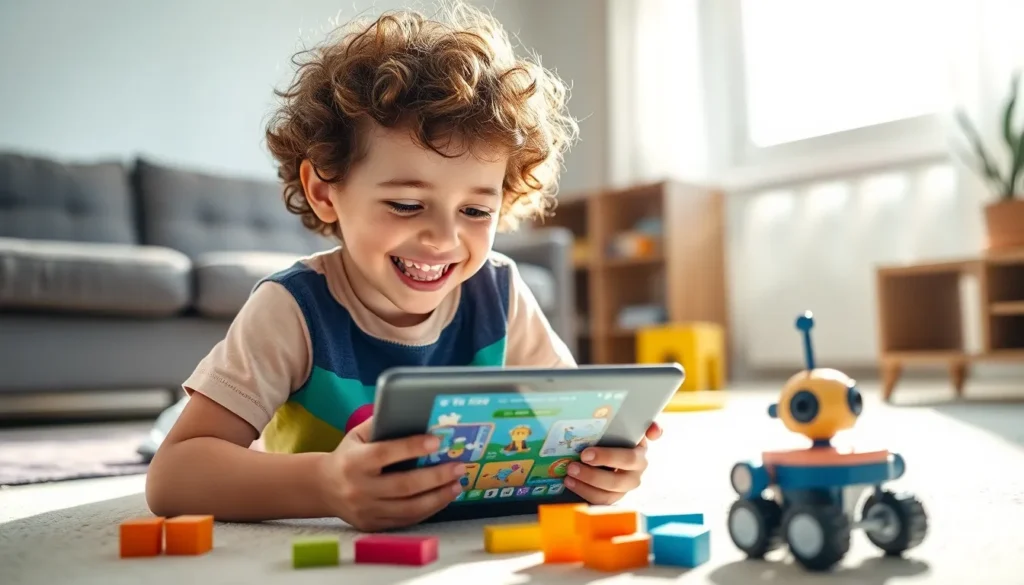In a world where kids are more tech-savvy than their parents, finding the right gadgets can feel like hunting for a unicorn. With so many options out there, it’s easy to get lost in a sea of flashing lights and endless apps. But fear not! The quest for the perfect gadget doesn’t have to be a wild goose chase.
Table of Contents
ToggleBenefits Of Gadgets For Kids
Gadgets offer several advantages for kids, fostering both educational and creative developments. Integrating technology into children’s lives can enhance their learning experiences and self-expression.
Educational Value
Gadgets provide access to a wealth of educational resources and tools. Interactive apps and games can engage kids in subjects like math, science, and reading, transforming learning into an enjoyable process. Many gadgets facilitate personalized learning experiences, allowing children to progress at their own pace. For example, tablets with educational software can improve literacy skills through interactive stories and quizzes. Additionally, technology encourages critical thinking and problem-solving by presenting challenges that require strategic solutions.
Enhancing Creativity
Gadgets stimulate creativity by offering numerous platforms for expression. Children can explore various forms of art, such as digital drawing or music creation applications, that inspire innovative thinking. For instance, programming toys fuse playtime with learning, allowing kids to experiment with coding and robotics while constructing their own projects. Moreover, gadgets enable sharing of creative work, providing feedback from peers and a sense of community, which reinforces motivation and creativity in an evolving digital landscape.
Popular Types Of Gadgets For Kids

Gadgets for kids come in various forms, each providing unique benefits to enhance learning and creativity. Understanding the different types helps parents make informed choices.
Tablets And E-Readers
Tablets and e-readers serve as versatile tools for children’s learning. Tablets, like the Amazon Fire Kids Edition or Apple iPad, offer access to educational apps, interactive games, and digital books. E-readers, such as the Kindle Kids Edition, promote a love for reading by providing a vast library of accessible titles. Both devices facilitate personalized learning experiences, allowing children to explore subjects at their own pace and interests.
Smart Toys And Interactive Games
Smart toys and interactive games integrate technology with play, promoting critical thinking and creativity. Examples include STEM-focused kits like LEGO Boost and Osmo, which engage kids in coding and robotics. Interactive games, such as the Nintendo Switch, encourage collaboration among peers while developing problem-solving skills. These gadgets combine fun with learning, making them ideal for children’s developmental growth.
Safety Considerations
Ensuring safety in gadget usage for kids is crucial. Parents must prioritize proper oversight.
Parental Controls
Parental controls play a vital role in managing children’s gadget use. Tools allow parents to restrict access to inappropriate content, monitor online activities, and set usage limits. For example, many devices like tablets and gaming consoles offer built-in parental control features to filter content, manage screen time, and block purchases.
Utilizing software options, such as Qustodio or Norton Family, further enhances control by providing insights into a child’s device interaction. Parents can customize settings based on age and maturity, ensuring a safer digital environment. Maintaining open communication about these controls fosters trust and promotes responsible gadget usage.
Screen Time Guidelines
Screen time guidelines help parents navigate gadget usage effectively. The American Academy of Pediatrics recommends limiting screen time for children aged 2 to 5 years to one hour of high-quality programming daily. For older children, establishing consistent limits while ensuring screens don’t interfere with sleep, physical activity, or face-to-face interactions is essential.
Encouraging breaks during usage promotes healthier habits. Parents can engage in co-viewing to discuss content, enhancing comprehension and critical thinking. Adhering to these guidelines supports balanced gadget use, contributing positively to children’s development.
Tips For Choosing The Right Gadgets
Selecting the right gadgets for kids involves careful consideration of various factors. Parents can streamline their decision-making process by focusing on age appropriateness and reputable brands.
Age Appropriateness
Age appropriateness plays a critical role in gadget selection. Devices designed for specific age groups offer tailored content and features that align with a child’s developmental stage. For example, toddlers benefit from interactive toys that enhance sensory skills, while older children thrive with educational tablets that support advanced learning. The American Academy of Pediatrics recommends checking age ratings on gadgets, as these ratings indicate suitable content. Choosing age-appropriate gadgets also helps prevent frustrations, ensuring that children engage positively and learn effectively.
Recommended Brands
Several brands excel at creating quality gadgets for kids. Parents can consider options from companies such as LeapFrog, known for educational tablets that cater to early learners, or VTech, which offers interactive toys and smartwatches designed for younger audiences. Third, Amazon provides the Fire Kids Edition tablet, featuring parental controls and a wealth of educational apps. Lastly, Osmo combines physical play with digital learning, making it a unique choice for interactive educational games. Opting for these reputable brands ensures access to safe, engaging, and valuable learning experiences for children.
Selecting the right gadgets for kids can be a rewarding experience when approached with the right knowledge. By focusing on age appropriateness and reputable brands, parents can ensure their children benefit from technology in a safe and engaging way. Gadgets not only enhance learning but also foster creativity and collaboration, making them valuable tools in a child’s development. With proper oversight and the right choices, technology can become a positive force in nurturing a child’s growth and curiosity. Embracing these tools can lead to enriching experiences that inspire the next generation of thinkers and creators.





